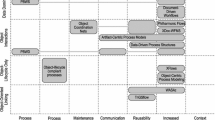Abstract
This paper proposes a framework for business process design, which is based on process comparison and integration. This framework supports process stakeholders to model business processes collaboratively, which can greatly enhance the efficiency and effectiveness of business process design. By applying this framework, each process stakeholder can create his or her own model of the business process. The different models of the same business process can be automatically compared to find the conflicts between them. Based on the conflicts, process stakeholders can collaborate to improve the models. Then the models can be integrated to form a more complete model.






Similar content being viewed by others
References
De Cesare, S., & Serrano, A. (2006). Collaborative modeling using UML and business process simulation. In Proceedings of the Annual Hawaii International Conference on System Sciences.
Dussart, A., Aubert, B. A., & Patry, M. (2004). An evaluation of inter-organizational workflow modeling formalisms. Journal of Database Management, 15(2), 74–104.
Embley, D. W. (1998). Object database development: Concepts and principles. Reading: Addison-Wesley.
Gunasekaran, A., & Kobu, B. (2002). Modelling and analysis of business process reengineering. International Journal of Production Research, 40(11), 2521–2546. doi:10.1080/00207540210132733.
Juan, Y.-C. (2006). A string comparison approach to process logic differences between business process models. In Proceedings of the 9th Joint Conference on Information Sciences.
Juan, Y. C., & Ou-Yang, C. (2005). A process logic comparison approach to support business process benchmarking. International Journal of Advanced Manufacturing Technology, 26(1–2), 191–210. doi:10.1007/s00170-003-1970-x.
Kalnins, A., Kalnina, D., & Kalis, A. (1998). Comparison of tools and languages for business process reengineering. In Proceedings of the Third International Baltic Workshop on Databases and Information Systems (pp. 24–38). Riga.
Koo, B. H. Y., Simmons, W. L., & Crawley, E. F. (2007). Algebra of systems: An executable framework for model synthesis and evaluation. In Proceedings of International Conference on Systems Engineering and Modeling-ICSEM, 07 (pp. 42–49). doi:10.1109/ICSEM.2007.373332.
Lu, S. C.-Y., & Cai, J. (2001). A collaborative design process model in the sociotechnical engineering design framework. Artificial Intelligence for Engineering Design, Analysis and Manufacturing: AIEDAM, 15(1), 3–20.
Rosen, K. H. (2003). Discrete mathematics and its applications. McGraw-Hill.
Seshasai, S., Gupta, A., & Kumar, A. (2005). An integrated and collaborative framework for business design: a knowledge engineering approach. Data & Knowledge Engineering, 52(1), 157–179. doi:10.1016/S0169-023X(04)00085-0.
Sun, S., Kumar, A., & Yen, J. (2006). Merging workflows: a new perspective on connecting business processes. Decision Support Systems, 42(2), 844–858. doi:10.1016/j.dss.2005.07.001.
Tsujigaclo, M. (1993). Application of CSP to the development of sequence control mechanisms. In Proceedings of IECON, 93 (pp. 2115–2120).
Wang, C. M. (1996). BASS: BPR Analogy Support System. Master Thesis: National Taiwan University of Science and Technology.
Zhang, J., & Wang, H.-Y. (2006). A composition-oriented approach for business process formal design. In Proceedings of the 10th International Conference on Computer Supported Cooperative Work in Design (pp. 449–454). Nanjing, China.
Acknowledgement
This research was supported by the grants from the National High Technology Research and Development Program of China (863 Program) (No. 2008AA04Z102) and the National Natural Science Foundation of China (No. 70771058 and 60834004)
Author information
Authors and Affiliations
Corresponding author
Rights and permissions
About this article
Cite this article
Xiao, L., Zheng, L. Business process design: Process comparison and integration. Inf Syst Front 14, 363–374 (2012). https://doi.org/10.1007/s10796-010-9251-3
Published:
Issue Date:
DOI: https://doi.org/10.1007/s10796-010-9251-3




